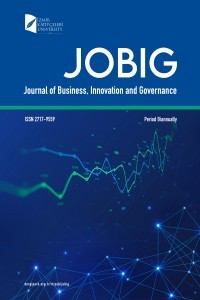ÇİFT-TARAFLI KUYRUK (BEKLEME) SİSTEMLERİNDE OPERASYON YÖNETİMİ
çift-taraflı kuyruk sistemleri, hizmet kapasitesi yönetimi, modelleme ve uygulama
OPERATIONS MANAGEMENT FOR DOUBLE-ENDED QUEUES
___
- Bhardwaj, R., Singh, T. P., & Kumar, V. (2014). A generalized double ended stochastic queue system with excess customer demand in real world situations. Arya Bhatta Journal of Mathematics and Informatics, 6(2), 247-260.Browne, J. J., Kelly, J. J., & Le Bourgeois, P. (1970). Maximum inventories in baggage claim: a double ended queuing system. Transportation Science, 4(1), 64-78.Degirmenci, I. T. (2010). Asymptotic analysis and performance-based design of large scale service and inventory systems (Doctoral dissertation, Department of Business Administration, Duke University).Di Crescenzo, A., Giorno, V., Kumar, B. K., & Nobile, A. G. (2012). A double-ended queue with catastrophes and repairs, and a jump-diffusion approximation. Methodology and Computing in Applied Probability, 14(4), 937-954.Di Crescenzo, A., Giorno, V., Krishna Kumar, B., & Nobile, A. (2018). A time-non-homogeneous double-ended queue with failures and repairs and its continuous approximation. Mathematics, 6(5), 81, 1-23.Diamant, A., & Baron, O. (2019). Double-sided matching queues: Priority and impatient customers. Operations Research Letters, 47(3), 219-224.Dobbie, J. M. (1961). Letter to the Editor—A Doubled-Ended Queuing Problem of Kendall. Operations Research, 9(5), 755-757.Dolhun, K. L. (1997). A double-ended single server queueing system. Unpublished master thesis. Faculty of Graduate Studies, University of Manitoba, Canada.Elalouf, A., Perlman, Y., & Yechiali, U. (2018). A double-ended queueing model for dynamic allocation of live organs based on a best-fit criterion. Applied Mathematical Modelling, 60, 179-191.Gaur, K. N., & Kashyap, B. R. K. (1973). The double-ended queue with limited waiting space. Indian Journal of Pure and Applied Mathematics, 4, 73-81.Herlihy, M., Luchangco, V., & Moir, M. (2003, May). Obstruction-free synchronization: Double-ended queues as an example. In 23rd International Conference on Distributed Computing Systems, 2003. Proceedings. (pp. 522-529). IEEE.Jain, M. (2000). GX/GY/1 double ended queue: diffusion approximation. Journal of Statistics and Management Systems, 3(2), 193-203.Kashyap, B. R. K. (1965). A double-ended queueing system with limited waiting space. In Proc. Nat. Inst. Sci. India (Vol. 31, No. 6, pp. 559-570).Kashyap, B. R. K. (1967). Further results for the double ended queue. Metrika, 11(1), 168-186.Kim, W. K., Yoon, K. P., Mendoza, G., & Sedaghat, M. (2010). Simulation model for extended double-ended queueing. Computers & Industrial Engineering, 59(2), 209-219.Koca, E., Sedaghat, M., & Yoon, K. P. (2014). Optimal Supply & Demand Balance In Service Environments. Journal of Service Science (Online), 7(1), 43-52.Lee, C., Liu, X., Liu, Y., & Zhang, L. (2019). Optimal Control of a Time-Varying Double-Ended Production Queueing Model. Available at SSRN 3367263.Liu, X. (2019). Diffusion approximations for double-ended queues with reneging in heavy traffic. Queueing Systems, 91(1-2), 49-87.Liu, X., Gong, Q., & Kulkarni, V. G. (2014). Diffusion models for double-ended queues with renewal arrival processes. Stochastic Systems, 5(1), 1-61.Mendoza, G., Sedaghat, M., & Yoon, K. P. (2009). Queuing models to balance systems with excess supply. International Business & Economics Research Journal (IBER), 8(1), 91-104.Pandey, M. K., & Gangeshwer, D. K. (2018). Applications of the Diffusion Approximation to Hospital Sector Using G∞/GM/1 Double Ended Queue Model. Journal of Computer and Mathematical Sciences, 9(4), 302-308.Shi, Y., & Lian, Z. (2016). Optimization and strategic behavior in a passenger–taxi service system. European Journal of Operational Research, 249(3), 1024-1032.Som, P., Wilhelm, W. E., & Disney, R. L. (1994). Kitting process in a stochastic assembly system. Queueing Systems, 17(3-4), 471-490.Wang, Y., & Liu, Z. (2019). Equilibrium and Optimization in a Double-Ended Queueing System with Dynamic Control. Journal of Advanced Transportation, 2019, 1-13.Wang, F., Wang, J., & Zhang, Z. G. (2017). Strategic behavior and social optimization in a double-ended queue with gated policy. Computers & Industrial Engineering, 114, 264-273.
- Yayın Aralığı: Yılda 2 Sayı
- Başlangıç: 2018
- Yayıncı: İzmir Katip Çelebi Üniversitesi
LEXUS VE ZEYTİN AĞACI: KÜRESELLEŞMENİN GELECEĞİ
RUSYA’NIN YAKIN ÇEVRE POLİTİKASI BAĞLAMINDA AZERBEYCAN-ERMENİSTAN ÇATIŞMASI
ULUSLARARASI TİCARETTE TAHSİL ESASINA DAYALI ÖDEME ŞEKİLLERİ (COLLECTION BASIS) ve UYGULAMA ADIMLARI
FİNANSAL RAPORLAMA STANDARTLARI VE UYGULAMALARI BAĞLAMINDA YENİ HESAP PLANI DÜZENLEMELERİ
Serhat BURMAOĞLU, Esra DÜNDAR ARAVACIK
SİNİZM: TÜRKİYE’DE SAĞLIK ALANINDA 2011-2018 YILLARI ARASINDAKİ ÇALIŞMALAR ÜZERİNE BİR DEĞERLENDİRME
ÇİFT-TARAFLI KUYRUK (BEKLEME) SİSTEMLERİNDE OPERASYON YÖNETİMİ
Aygülen KARAKUL, Gizem ÖZAYDIN
SOSYAL MEDYA FENOMENLERİ: INSTAGRAM VE KOZMETİK SEKTÖRÜNDE BİR UYGULAMA
